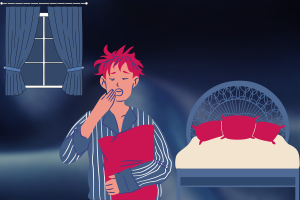This post contains affiliate links
Sleepwalking
 Sleepwalking, also known as somnambulism, is moving or doing something when not fully awake. Usually it happens when the sleepwalker has entered deep sleep, which mostly happens at the start of the night, so sleepwalkers are most likely to sleepwalk in the hours shortly after going to sleep.
Sleepwalking, also known as somnambulism, is moving or doing something when not fully awake. Usually it happens when the sleepwalker has entered deep sleep, which mostly happens at the start of the night, so sleepwalkers are most likely to sleepwalk in the hours shortly after going to sleep.
Sleepwalking is most common in children. About one in five children between the ages of three and eight years old may do this at times. Sleepwalking typically decreases during adolescence, but it may continue into adulthood. It is not uncommon for adults to have episodes of sleep walking.
Causes of Sleepwalking
The actual cause of sleepwalking is unknown: there may be many causes. When we sleep, our muscles are paralysed, so that we can dream but not move while dreaming, so sleepwalking has to overcome this. Oftentimes, it’s associated with a stressful environment and an irregular sleep schedule, which may also be associated with sleep apnea and snoring. The best way to deal with sleep walking is to set a consistent sleeping schedule. If symptoms persist, it’s best to consult a doctor. A doctor can also prescribe medication to treat sleepwalking.
While the exact mechanism of sleep walking is still unclear, current evidence suggests several components. The most compelling mechanistic hypothesis would involve a synthesis of the disorders of slow-wave sleep, arousals, and simultaneous dissociative states of wakefulness and sleep. Ultimately, further studies are needed to clarify its genetic basis and determine the neurobiochemical and neurophysiological mechanisms underlying sleepwalking.
Effects of Sleepwalking
Somnambulism is associated with a decreased ability to think clearly. People who sleepwalk often experience sleep talking, incoherent talking, glassy eyes, and slow responses. In some cases, sleepwalkers even talk and scream, even while they are asleep. However, this behavior may not be noticeable to other people. People who experience sleepwalking may experience episodes lasting up to 30 minutes. However, most episodes are brief, lasting under 10 minutes.
sleepwalk often experience sleep talking, incoherent talking, glassy eyes, and slow responses. In some cases, sleepwalkers even talk and scream, even while they are asleep. However, this behavior may not be noticeable to other people. People who experience sleepwalking may experience episodes lasting up to 30 minutes. However, most episodes are brief, lasting under 10 minutes.
Dealing with Sleepwalking
 fatigue. These factors can make sleep walking more likely and dangerous. In addition to eliminating potential hazards, proper sleep hygiene, including dealing with snoring and sleep apnea, is important for reducing sleep walking.
fatigue. These factors can make sleep walking more likely and dangerous. In addition to eliminating potential hazards, proper sleep hygiene, including dealing with snoring and sleep apnea, is important for reducing sleep walking.
The most effective way to prevent sleep walking is to practice anticipatory awakening, which is known to prevent partial awakenings that lead to sleepwalking. Another way to avoid the problem is to establish a “power-down” hour before bedtime. This will help the sleeper relax and reduce the risk of injury during a sleepwalking episode.
Dealing with Sleepwalkers
A jarring awakening can cause a sleepwalker to become disoriented and confused. If you wake someone who is sleepwalking, it is best to gently guide them back to bed. This way, they won’t react violently and won’t be frightened or confused. Eventually, sleepwalkers will go back to bed. When they’re ready, they’ll be able to return to their normal sleep and wake up on their own.
People with sleep walking should be kept away from dangerous objects. While the condition may be harmless, the consequences can be serious. During the day, sufferers of somnambulism often experience excessive fatigue and poor quality of sleep. Therefore, they should be watched closely for signs of sleepiness and seek medical attention if necessary. Approximately 45% of people who experience somnambulism experience sleepiness during the day. Sleepiness can have a major impact on the person’s life, including dangers when driving or operating machinery.
Symptoms of Sleepwalking
These may include agitation and confusion, inability to control bladder movements, and an increase in frequency of urination while sleepwalking. The episodes can be worse when the child has a fever or is stressed. When parents discover that their child has begun sleepwalking, they should not attempt to wake them up, but should gently redirect them back to bed. Maintaining a regular sleep schedule can also prevent sleepwalking episodes from recurring. Furthermore, parents should ensure that the environment in the home is safe for children. In addition, they should remove any objects that may be dangerous.
Sleepwalking can be a serious problem. Not only can it cause the somnambulist to trip over or collide with objects while walking or running, but it can also affect their ability to drive. Moreover, sleepwalkers may be more likely to become violent and agitated, which can hurt themselves and others. They may also be embarrassed if they urinate in inappropriate locations.
Mental Disorder
Sleepwalking is most common in children and adolescents, but it can also affect adults. One study published in 2016 found that 5% of children and 1.5% of adults reported sleep walking at some point in their lives. Fortunately, most children who engage in sleep walking outgrow the condition as they grow older. If the behavior continues, it may signal the onset of a psychiatric or medical disorder. If the disorder is severe enough, the disorder may be treated.